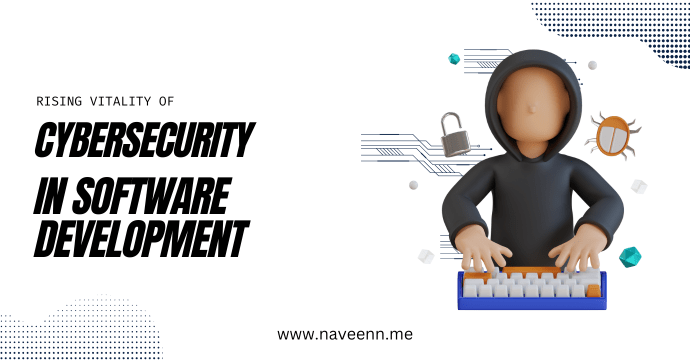In our digital age, cybersecurity in software development is crucial. With cyber threats becoming more sophisticated and pervasive, the need for robust security measures has never been more critical.
In this blog post, we will explore why cybersecurity has become a vital component of software development and how developers can integrate security practices into their workflows to protect their applications and users.
Understanding the Cybersecurity Landscape
The cybersecurity landscape is ever-changing, with daily new threats. From data breaches and ransomware attacks to phishing scams and distributed denial-of-service (DDoS) attacks, the variety and complexity of cyber threats are growing.
According to recent studies, the global cost of cybercrime is expected to reach $10.5 trillion annually by 2025, highlighting the significant financial impact of inadequate cybersecurity measures.
The Importance of Cybersecurity in Software Development
- Protecting Sensitive Data: One of the primary reasons cybersecurity is crucial in software development is the need to protect sensitive data. Applications often handle personal information, financial data, and other confidential details. A security breach can result in the exposure of this data, leading to identity theft, financial loss, and damage to a company’s reputation.
- Maintaining User Trust: User trust is paramount for the success of any software application. Users expect that their data will be handled securely and that the software they use will protect them from cyber threats. Failing to implement adequate security measures can erode user trust, leading to a loss of customers and a tarnished brand image.
- Adhering to Regulations: Numerous industries face strict data security and privacy rules. Laws such as the General Data Protection Regulation (GDPR) in Europe and the Health Insurance Portability and Accountability Act (HIPAA) in the United States mandate rigorous security standards. Failing to comply may lead to hefty penalties and legal consequences.
- Preventing Financial Loss: The financial implications of a cyberattack can be devastating. Companies may face costs related to incident response, legal fees, regulatory fines, and loss of business. By integrating cybersecurity into the software development process, organizations can mitigate the risk of financial loss due to cyber incidents.
Read More: How to Choose the Best Software Development Company
Best Practices for Integrating Cybersecurity into Software Development
To effectively address cybersecurity concerns, developers must adopt best practices that incorporate security throughout the software development lifecycle (SDLC). Here are some key strategies:
Implement Secure Coding Practices: Secure coding practices are essential for preventing vulnerabilities in software. Developers should adhere to established guidelines and standards, such as the OWASP Top Ten, which outlines the most critical security risks. Key practices include:
- Input Validation: Ensure that all input is validated to prevent injection attacks.
- Output Encoding: Encode output to prevent cross-site scripting (XSS) attacks.
- Secure Access Control: Employ robust authentication and authorization systems for resource management.
- Error Handling: Properly handle errors to avoid revealing sensitive information.
Conduct Regular Security Testing: Regular security testing is vital for identifying and addressing vulnerabilities. Developers should perform various types of testing, including:
- Static Application Security Testing (SAST): Analyzes source code for vulnerabilities without executing the code.
- Dynamic Application Security Testing (DAST): Tests the running application to identify security issues in real-time.
- Penetration Testing: Simulates real-world attacks to uncover potential weaknesses.
Adopt DevSecOps Practices: DevSecOps integrates security into the DevOps workflow, ensuring that security is a shared responsibility throughout the development process. Key DevSecOps practices include:
- Automated Security Testing: Integrate security testing tools into the CI/CD pipeline to automatically detect vulnerabilities.
- Continuous Monitoring: Monitor applications and infrastructure for security threats continuously.
- Collaboration: Foster collaboration between development, security, and operations teams to address security issues promptly.
Educate and Train Developers: Security awareness and training are crucial for empowering developers to create secure software. Organizations should provide ongoing training on the latest cybersecurity threats and best practices. This includes:
- Security Workshops: Conduct hands-on workshops to teach developers how to identify and mitigate security risks.
- Online Courses: Offer access to online courses and certifications focused on secure coding and cybersecurity.
- Regular Updates: Keep developers informed about emerging threats and new security techniques.
Utilize Secure Development Frameworks and Libraries: Using secure development frameworks and libraries can help developers avoid common security pitfalls. These tools often include built-in security features, such as input validation and encryption, that simplify the implementation of secure practices. Examples include:
- Spring Security: A framework for securing Java applications.
- Express.js Security Best Practices: Guidelines for securing Node.js applications built with Express.js.
- OWASP Dependency-Check: A tool for identifying vulnerabilities in project dependencies.
Conclusion
The rising vitality of cybersecurity in software development is undeniable. As cyber threats continue to evolve, developers must prioritize security to protect sensitive data, maintain user trust, comply with regulations, and prevent financial loss.
By implementing secure coding practices, conducting regular security testing, adopting DevSecOps, educating developers, and utilizing secure frameworks, organizations can build resilient software that withstands the ever-changing cybersecurity landscape.

Pingback: Benefits of Using Agile Methodology in Software Development
Pingback: A Complete Guide to the Various Types of Software Testing